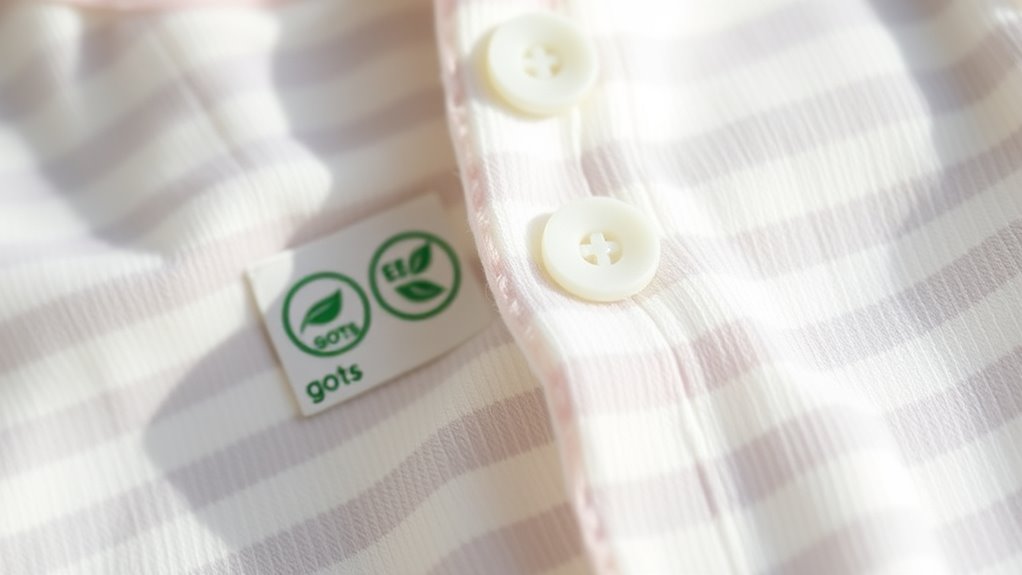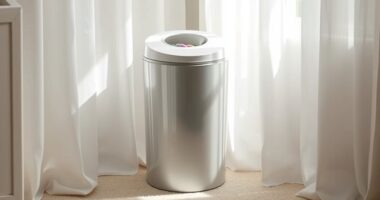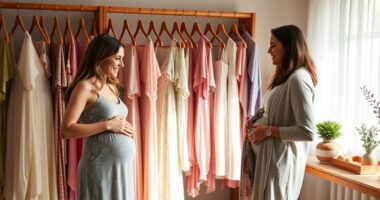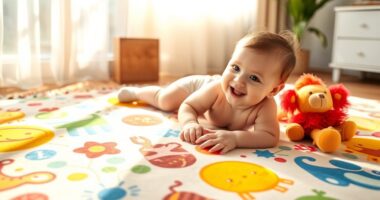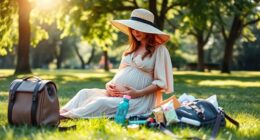Choosing sustainable baby clothing means opting for fabrics like organic cotton, hemp, and bamboo that are grown without harmful chemicals and using eco-friendly farming methods. Look for certifications like GOTS and OEKO-TEX, which guarantee the textiles are safe, chemical-free, and ethically produced. These choices help protect your baby’s delicate skin and support environmental conservation. Curious about which fabrics and certifications are best? Keep exploring to find out more about making eco-conscious clothing choices.
Key Takeaways
- Organic fabrics like cotton, hemp, and bamboo are grown without harmful chemicals, promoting environmental health and baby safety.
- Eco-friendly dyes reduce chemical exposure and environmental impact, ensuring safe, vibrant colors for baby clothing.
- Certifications such as GOTS and OEKO-TEX verify that fabrics meet strict safety, sustainability, and chemical-free standards.
- Choosing certified sustainable fabrics supports ethical manufacturing, reduces pollution, and conserves water and resources.
- Sustainable baby clothing prioritizes health, safety, and ecological balance through eco-friendly materials and certified processes.
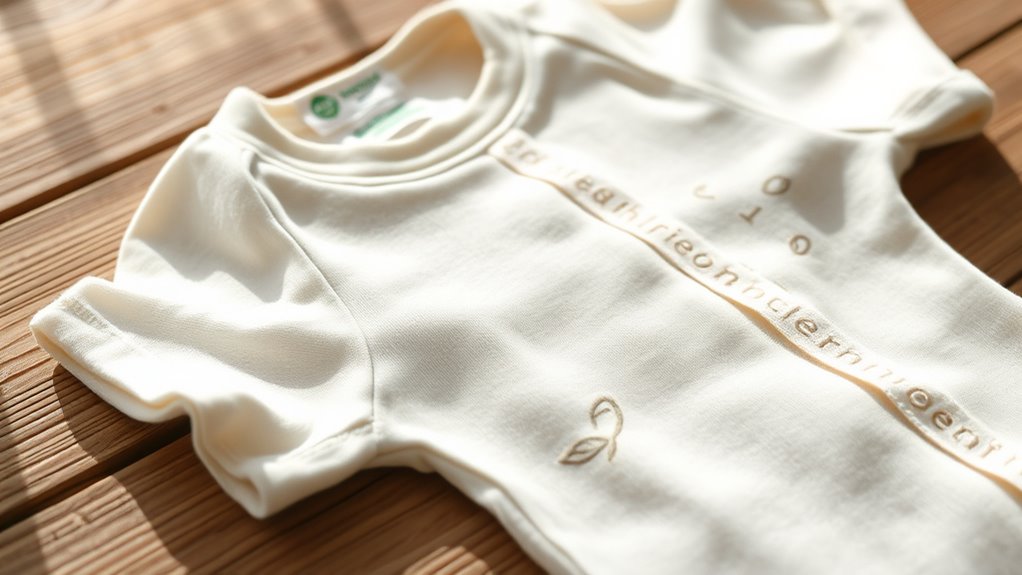
Choosing sustainable baby clothing is an important step toward protecting your child’s future and reducing environmental impact. When you select clothing made from organic fibers, you’re opting for fabrics that are grown without harmful pesticides or synthetic chemicals. Organic fibers like organic cotton, hemp, and bamboo are cultivated using environmentally friendly farming practices, which help preserve soil health, conserve water, and avoid toxic residues. These fibers are naturally soft and breathable, making them ideal for a baby’s sensitive skin. By choosing organic, you reduce your baby’s exposure to potentially irritating substances found in conventional textiles and support farming methods that prioritize ecological balance.
Choosing organic fibers for baby clothes supports eco-friendly farming and protects sensitive skin.
In addition to the fibers themselves, pay attention to how the dyes are applied. Eco friendly dyes are essential because they are produced with non-toxic, low-impact processes that minimize water and energy consumption. Unlike conventional dyes, which often contain harmful chemicals like heavy metals and formaldehyde, eco friendly dyes are made from natural or low-impact synthetic sources that are safer for your baby and better for the environment. When clothes are dyed with eco friendly dyes, you can feel confident that you’re reducing your child’s exposure to chemical irritants and supporting sustainable manufacturing practices.
Certifications are your best guide when shopping for truly sustainable baby clothing. Look for labels such as GOTS (Global Organic Textile Standard), which certifies that fibers are organic and that the entire manufacturing process adheres to strict environmental and social criteria. Another reputable certification is OEKO-TEX Standard 100, which verifies that textiles are free from harmful substances, ensuring safety for your baby’s delicate skin. When you see these labels, you know the clothing has undergone rigorous testing and meets high standards for sustainability and safety.
Choosing clothing with these certifications, along with fabrics made from organic fibers and dyed with eco friendly dyes, guarantees you’re making an environmentally conscious choice. It also promotes better health for your baby, free from chemical residues that can cause skin sensitivities or allergic reactions. Additionally, selecting sustainable fabrics supports ethical manufacturing practices that prioritize fair labor and environmental stewardship. By prioritizing sustainable fabrics and certified processes, you’re not only protecting your child but also contributing to a healthier planet. You actively participate in reducing pollution, conserving resources, and supporting fair labor practices, all through simple, thoughtful purchasing decisions. Ultimately, selecting sustainable baby clothing based on these fabrics and certifications is a meaningful way to start your child’s lifelong journey of environmental awareness and responsibility.
Frequently Asked Questions
How Do Sustainable Fabrics Compare in Cost to Conventional Ones?
Sustainable fabrics tend to be more expensive than conventional ones initially, but their fabric durability often justifies the price. You might notice price fluctuations depending on the source and certification, but investing in eco-friendly materials can save you money over time, as they last longer and reduce need for frequent replacements. Overall, while the upfront cost is higher, the long-term benefits make sustainable fabrics a worthwhile choice for your baby’s clothing.
Are There Specific Certifications That Guarantee Eco-Friendly Baby Clothing?
You’re right to ask if there are certifications that guarantee eco-friendly baby clothes. Yes, several certifications like GOTS (Global Organic Textile Standard) and OEKO-TEX verify fabrics meet strict organic and environmental standards. These eco label standards confirm that the clothing is free from harmful chemicals and sustainably produced. Always look for these labels to make sure your little one’s clothes are genuinely eco-friendly and safe, because you want the best for your baby.
How Can I Identify Authentic Sustainable Baby Clothing Brands?
You can identify authentic sustainable baby clothing brands by checking their brand transparency and commitment to ethical manufacturing. Look for clear information about their sourcing, production processes, and labor practices on their websites. Reputable brands often share detailed supply chain info and third-party certifications. Trust brands that openly communicate their sustainability efforts, prioritize fair labor, and use eco-friendly fabrics, ensuring you’re choosing genuinely sustainable options for your baby.
What Are the Environmental Impacts of Common Baby Clothing Fabrics?
Imagine you’re in a Victorian factory—today’s fabrics still impact the environment. Cotton, for instance, uses lots of water and chemicals, leading to water pollution and chemical runoff that harms ecosystems. Synthetic fabrics like polyester shed microplastics, polluting oceans. Choosing eco-friendly options like organic cotton or bamboo reduces these impacts, helping protect water quality. Your fabric choice directly affects the environment, so opt for sustainable, certified materials whenever possible.
How Long Do Sustainable Fabrics Typically Last With Regular Washing?
Sustainable fabrics generally last about the same as conventional ones with regular washing, often enduring 20-50 washes depending on the material. Fabric durability varies, but eco-friendly options like organic cotton and hemp tend to hold up well if you follow recommended washing frequency. To maximize longevity, wash on gentle cycles, avoid harsh detergents, and skip the dryer when possible. Proper care guarantees your sustainable baby clothing stays in good condition longer.
Conclusion
Choosing sustainable baby clothing not only benefits your little one but also helps protect the planet. Did you know that the global organic textile market is projected to grow at a compound annual growth rate of 11.3% through 2027? By selecting eco-friendly fabrics and certified brands, you contribute to reducing environmental impact and supporting ethical practices. Every small choice matters—so go ahead, dress your baby in comfort and conscience, and make a positive difference today.
